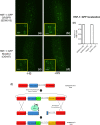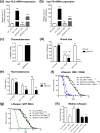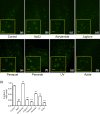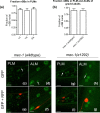HSF-1 displays nuclear stress body formation in multiple tissues in Caenorhabditis elegans upon stress and following the transition to adulthood
- PMID: 33392968
- PMCID: PMC7925714
- DOI: 10.1007/s12192-020-01188-9
HSF-1 displays nuclear stress body formation in multiple tissues in Caenorhabditis elegans upon stress and following the transition to adulthood
Abstract
The transcription factor heat shock factor-1 (HSF-1) regulates the heat shock response (HSR), a cytoprotective response induced by proteotoxic stresses. Data from model organisms has shown that HSF-1 also has non-stress biological roles, including roles in the regulation of development and longevity. To better study HSF-1 function, we created a C. elegans strain containing HSF-1 tagged with GFP at its endogenous locus utilizing CRISPR/Cas9-guided transgenesis. We show that the HSF-1::GFP CRISPR worm strain behaves similarly to wildtype worms in response to heat and other stresses, and in other physiological processes. HSF-1 was expressed in all tissues assayed. Immediately following the initiation of reproduction, HSF-1 formed nuclear stress bodies, a hallmark of activation, throughout the germline. Upon the transition to adulthood, of HSF-1 nuclear stress bodies appeared in most somatic cells. Genetic loss of the germline suppressed nuclear stress body formation with age, suggesting that the germline influences HSF-1 activity. Interestingly, we found that various neurons did not form nuclear stress bodies after transitioning to adulthood. Therefore, the formation of HSF-1 nuclear stress bodies upon the transition to adulthood does not occur in a synchronous manner in all cell types. In sum, these studies enhance our knowledge of the expression and activity of the aging and proteostasis factor HSF-1 in a tissue-specific manner with age.
Keywords: Aging; C. elegans; Cell stress; HSF-1; Heat shock response; Nuclear stress bodies.
Conflict of interest statement
The authors declare that they have no conflict of interest.
Figures






Similar articles
-
The genome-wide role of HSF-1 in the regulation of gene expression in Caenorhabditis elegans.BMC Genomics. 2016 Aug 5;17:559. doi: 10.1186/s12864-016-2837-5. BMC Genomics. 2016. PMID: 27496166 Free PMC article.
-
Caenorhabditis elegans HSF-1 is an essential nuclear protein that forms stress granule-like structures following heat shock.Aging Cell. 2013 Feb;12(1):112-20. doi: 10.1111/acel.12024. Epub 2012 Nov 23. Aging Cell. 2013. PMID: 23107491 Free PMC article.
-
Hormetic heat shock and HSF-1 overexpression improve C. elegans survival and proteostasis by inducing autophagy.Autophagy. 2017 Jun 3;13(6):1076-1077. doi: 10.1080/15548627.2017.1299313. Epub 2017 Mar 23. Autophagy. 2017. PMID: 28333578 Free PMC article.
-
The Thermal Stress Coping Network of the Nematode Caenorhabditis elegans.Int J Mol Sci. 2022 Nov 28;23(23):14907. doi: 10.3390/ijms232314907. Int J Mol Sci. 2022. PMID: 36499234 Free PMC article. Review.
-
Heat shock and genetic activation of HSF-1 enhance immunity to bacteria.Cell Cycle. 2006 Nov 1;5(21):2443-6. doi: 10.4161/cc.5.21.3434. Epub 2006 Sep 25. Cell Cycle. 2006. PMID: 17106259 Review.
Cited by
-
On the Roles of the Nuclear Non-Coding RNA-Dependent Membrane-Less Organelles in the Cellular Stress Response.Int J Mol Sci. 2023 Apr 30;24(9):8108. doi: 10.3390/ijms24098108. Int J Mol Sci. 2023. PMID: 37175815 Free PMC article. Review.
-
Keeping up with the condensates: The retention, gain, and loss of nuclear membrane-less organelles.Front Mol Biosci. 2022 Sep 20;9:998363. doi: 10.3389/fmolb.2022.998363. eCollection 2022. Front Mol Biosci. 2022. PMID: 36203874 Free PMC article. Review.
-
The CBP-1/p300 Lysine Acetyltransferase Regulates the Heat Shock Response in C. elegans.Front Aging. 2022 Apr 27;3:861761. doi: 10.3389/fragi.2022.861761. eCollection 2022. Front Aging. 2022. PMID: 35821825 Free PMC article.
-
HSF-1: Guardian of the Proteome Through Integration of Longevity Signals to the Proteostatic Network.Front Aging. 2022 Jul 8;3:861686. doi: 10.3389/fragi.2022.861686. eCollection 2022. Front Aging. 2022. PMID: 35874276 Free PMC article. Review.
-
Gene bookmarking by the heat shock transcription factor programs the insulin-like signaling pathway.Mol Cell. 2021 Dec 2;81(23):4843-4860.e8. doi: 10.1016/j.molcel.2021.09.022. Epub 2021 Oct 13. Mol Cell. 2021. PMID: 34648748 Free PMC article.
References
Publication types
MeSH terms
Substances
Grants and funding
LinkOut - more resources
Full Text Sources
Other Literature Sources
Medical

